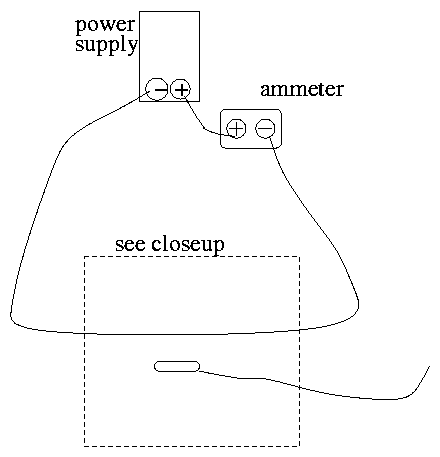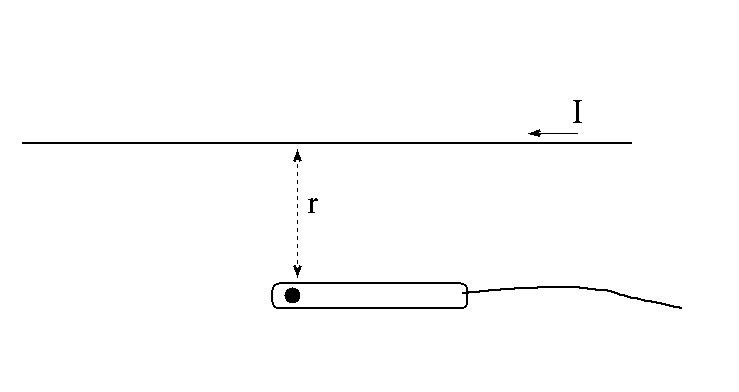To see how currents running through wires can create
magnetic fields, and how the strength of those magnetic fields
depends on distance from the wire.
Even if you don't have a magnet, you can still create
a magnetic field. The current passing through a wire
will create a magnetic field near the wire. Ampere's
Law can help you to figure out the strength of such a field
in some circumstances.
- Set up a current through a straight section of wire
- Stick together 8 or so patch cords to make a long
piece of wire. Connect it to a power supply and ammeter so that
there's a straight section at least two feet long which sits
as far from the power supply as possible, like this:

Turn on the power supply. Because the patch cords provide
only a very small resistance, a large current will run through
them. The power supply's built-in current limiter should activate --
you'll see the red bulb above "C.C." light up -- preventing the
current from rising too high.
Use the ammeter
to read the current running through the wire.
It should be somewhere between 1 and 3 amps.
If the current is above 3 amps, adjust the power supply
so that it goes down to 3 amps.
- Prepare the magnetic field probe
- Turn on one of the lab computers, and connect it to the
Vernier controller. Plug in the magnetic field probe.
Make sure that the toggle switch on the probe's black box
is set to "Amplification = high x200".
Start the Logger Pro program, and prepare
to acquire data in the following manner:
20 samples per second, for 3 seconds.
Verify that you can collect a set of data with
the probe just sitting anywhere on the table.
Use the Statistics function of Logger Pro
to calculate the mean value of the magnetic field.
What are the units?
Place the probe so that it lies parallel to the
straight section of the wire. Twist the probe
so that the white dot is pointing straight up,
as shown.

When the current is flowing, it will create a magnetic
field around the wire. Which way will the magnetic field
point? Indicate the direction of the magnetic field
near the position of the probe in the figure above.
Measure the magnetic field when the power supply is turned off;
you are detecting a "background" consisting of the Earth's
magnetic field as well as components generated by electrical
appliances in the room.
Then turn the power supply on and measure the field again;
your probe now detects the "background" plus the field generated
by the current running through the wire.
The difference between the two readings is the magnetic field
created by the current in the wire alone.
- Measure the magnetic field strength at a range of distances
- You may have noticed that the magnetic field probe is very
sensitive to its exact location and orientation.
You are going to move the probe to different places near
the wire, and that will cause the baseline reading of the
probe to change. Go ahead and move the probe around on
the tabletop, and watch its reading vary. How large
are the changes from place to place?
In order to determine only the magnetic field produced by the
wire, and not the changes in the ambient magnetic field,
you need to make a differential measurement like so:
- put the probe at some desired location
- collect one set of data with the power supply turned off;
take the mean value and call it B(off)
- now turn the power supply on and collect another set;
take the mean value and call it B(on)
- calculate the magnetic field produced by the wire as
B = B(on) - B(off)
Start with the probe on the side of the wire away from the
power supply. Place it a distance of r = 20 cm
and measure the field strength B.
Write down your results.
Then acquire more measurements at distances r of
18, 16, 12, 10, 8, 6, 5, 4, 3, 2, 1 cm.
- Move to the other side of the wire
- So far, the probe has always been on the same side of the wire,
on the side far away from the power supply. What will happen if
you move the probe to the other side, so it sits between the
wire and the power supply? Predict the measurement
you will obtain at a distance of 1 cm away from the wire on that
other side.
Now, actually move the probe to the other side of the wire.
Make sure that the white dot still faces straight up, and
make the measurement. Was your prediction correct? If not, can you
explain what changed as you moved the probe from one side of the
wire to the other? Perhaps it would help to draw the direction
of the magnetic field on both sides of the wire in the diagram
above....
Make measurements on this other side of the wire at the same
set of distances: 1, 2, 3, 4, 5, 6, 8, 10, 12, 16, 18, 20 cm.
- Analyze your results numerically
-
How does the strength of the magnetic field change with distance
from the wire? It clearly becomes weaker with increasing distance ...
but in what way? Is the relationship between magnetic field
B and distance from the wire r
B = k1 / r^2
or is it
B = k2 / r
or perhaps
- r
B = k3 * e
One way to decide is to look at your data in a numerical fashion.
Consider your measurement of B at the distance r = 3 cm.
If the first model is correct, what should happen to the magnetic field
strength if you double the distance? Should it be cut in half, or
by some other factor? Then look at the measurement at double
the distance, r = 6 cm. Does it agree with the model's
prediction? What about the other models?
- Analyze your results graphically
- Another way to compare models to a dataset is on a graph.
Start by drawing axes on the graph paper provided. Place
"Distance from the wire" on the horizontal axis, and
"Strength of magnetic field" on the vertical axis.
Use the absolute value of the magnetic field strength,
so that all your measurements become positive numbers;
do the same for your distances, too, if you recorded
distances on the two sides of the wire with different signs.
Figure out how large you'll have to draw each axis to
contain all of your measurements, plus leave a little room
for clarity.
Plot all your measurements on this graph. You should have
two values at each distance, one from each side of the wire.
Now, how can we compare the models to the data on this
graph? We will normalize all three
mathematical functions,
B = k1 / r^2
B = k2 / r
- r
B = k3 * e
so that they match the graph exactly at one point, somewhere
in the middle of the range. We'll use r = 4 cm as
the point in common. Calculate the average value of your
magnetic field strength at this distance.
For each of the three functions,
- use your average value of B and r = 4 cm
to calculate the constant (k1 or k2 or k3)
in the mathematical function
- now that you have the constant, you can evaluate the function
at any distance r. Calculate the value
of the function at five or six other distances,
covering the entire range of your graph.
Place a small dot at each point.
- draw a smooth line connecting these dots, and label the
line so you know which function it belongs to
If one of the mathematical models is a good match to reality,
then it ought to follow the actual measured values pretty closely.
All of the lines will run through the data at r = 4 cm,
but which of them does the best job of matching the data
at other distances?

